Right in the chaotic centre of Naples there is a beautiful and peaceful convent garden – the Cloister of Santa Chiara.
In August 2022 we fulfilled a long-delayed ambition to return to Naples. Our first visit over ten years earlier was only a short day trip by train from Sorrento, so this time we wanted to do it properly. That meant staying in downtown Naples for a few nights. Which meant driving into central Naples – in terms of risk something akin to skydiving in many people’s view, including that of northern Italians.
The traffic on a Naples city street, if it is wide enough, resembles a sort of slow-motion version of F1 cars weaving about for advantage as they leave the starting grid. There was a fair bit of hooting and gesticulation but I just kept going and we reached our destination without incident. The receptionist at the hotel said something to the effect that in Naples traffic, “they all do what they want and you let it happen around you”. That was good advice. In any case taxis are cheap in Naples and we were able to leave the car in the hotel garage until it was time to go home.
There are many stereotypes about Naples in addition to the traffic, and most are in some degree true. It is louder there, and more chaotic. The colours are brighter. The architecture – from later eras – is exuberant. There’s a big volcano across the bay. People genuinely seem more cheerful and demonstrative than they are further north – we noticed this in a few different situations. It is undeniably dirty, with the corruption in local government evident in rubbish collection contracts let to criminal groups that just dump stuff in random locations, or don’t bother collecting it at all. And as I said, the traffic is a bit crazy, although in our experience it is scarier in Palermo.
We read somewhere that if visitors to Italy find Rome dirty and disorganised, they should not go to Naples, because they will find those things worse there. If on the other hand they enjoy the energy and spectacle of Rome then they should keep going south because they will love Naples. We are in that latter category.
We were there in late August, and along the Lungomare and in the water the locals were soaking up the late summer sun.
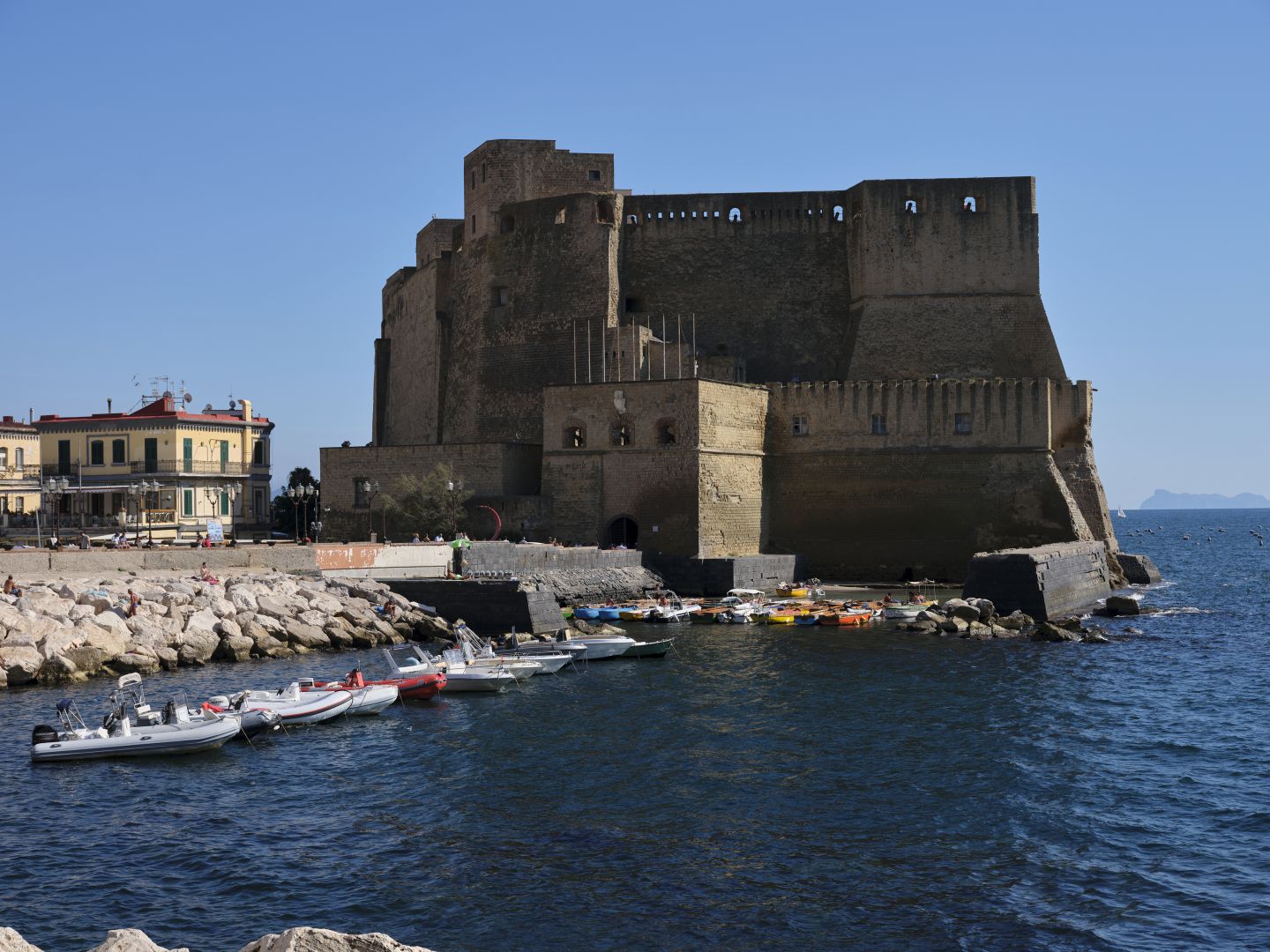
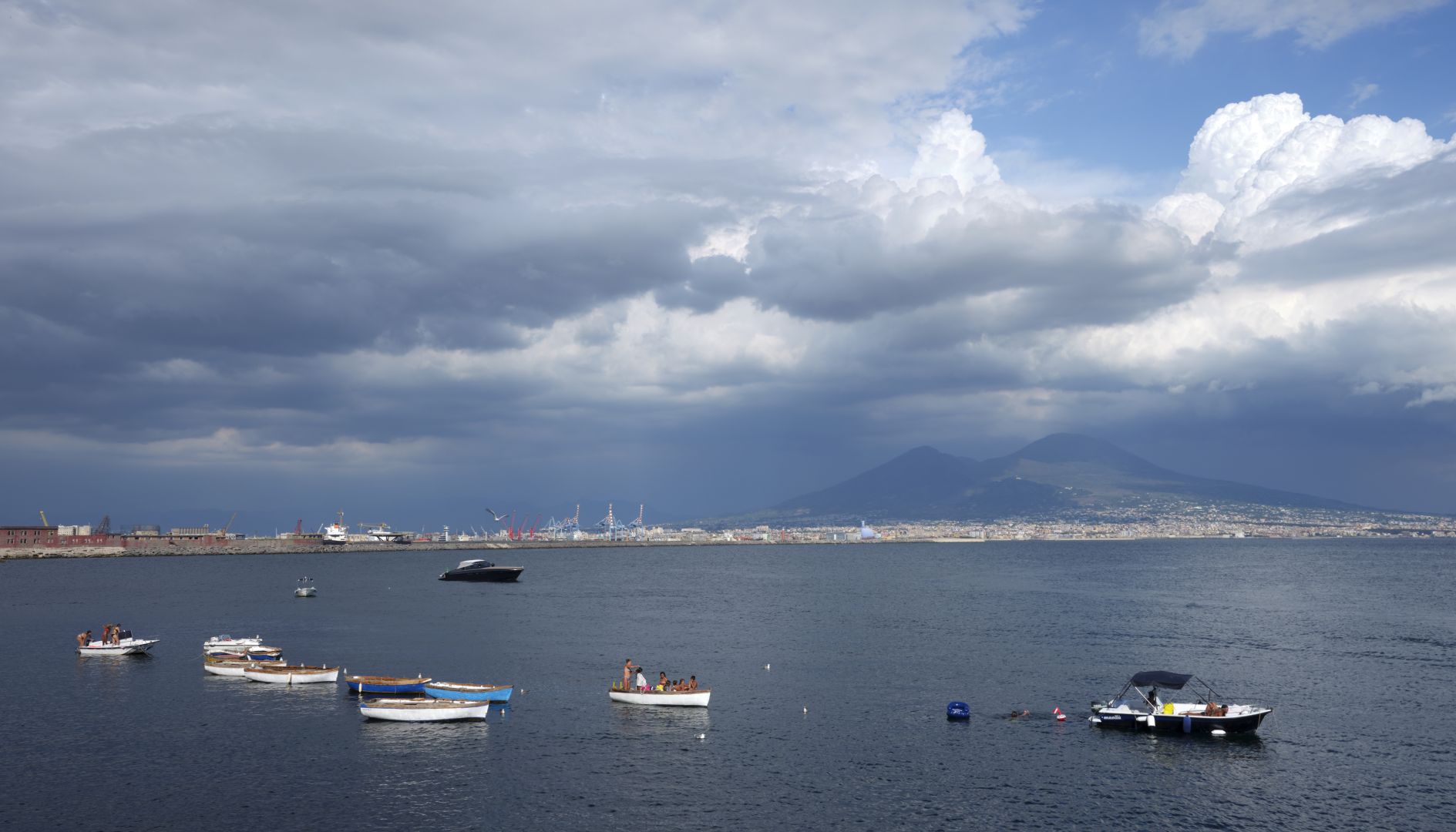
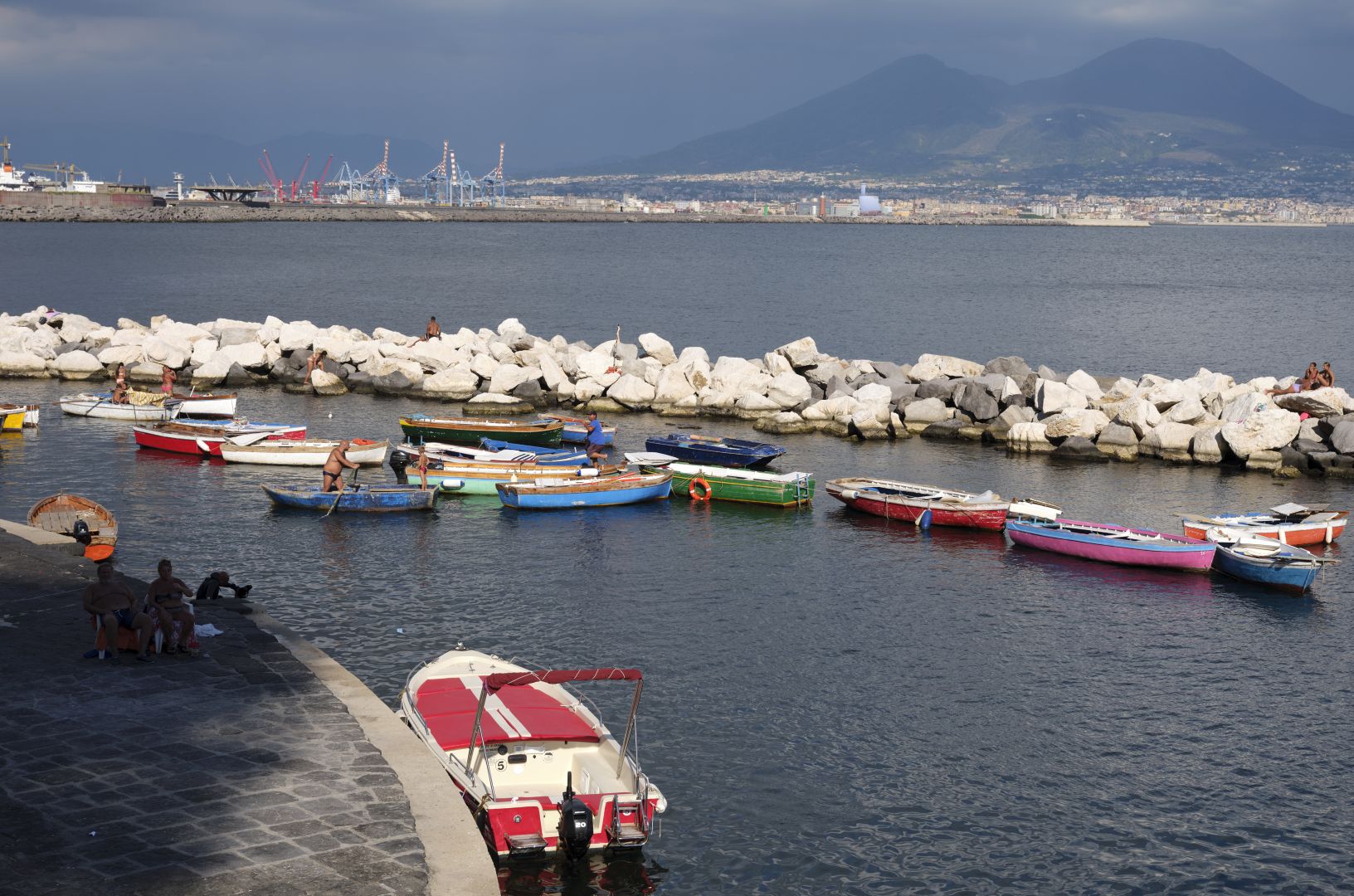
We took a most enjoyable day trip to the island of Procida – although that is not the subject of today’s post. I will also do a separate post one day celebrating street life in Naples. But now I will get to the point of this one.
Santa Chiara
One morning we woke to steady rain – welcome in a way after a particularly long, hot, dry summer, but not the best for sightseeing. Nonetheless we stuck to the plan, and after a breakfast of coffee and pastries at a bar we caught a taxi to our destination: the church, convent and cloisters of Santa Chiara, bang in the middle of the old city. As we zoomed up and down hills, ducked through narrow alleys, and negotiated one hairpin bend so tight that our little Fiat taxi had to do a three-point turn to get round, Lou observed that if there is a Naples equivalent of “The Knowledge” that London taxi drivers need to demonstrate, it would be challenging indeed. Needless to say the driver dropped us right at the front gate of our destination, and charged us very little.
In the photograph of central Naples below, taken from Castel Sant’Elmo, the church of Santa Chiara is the large green-roofed building on the right.
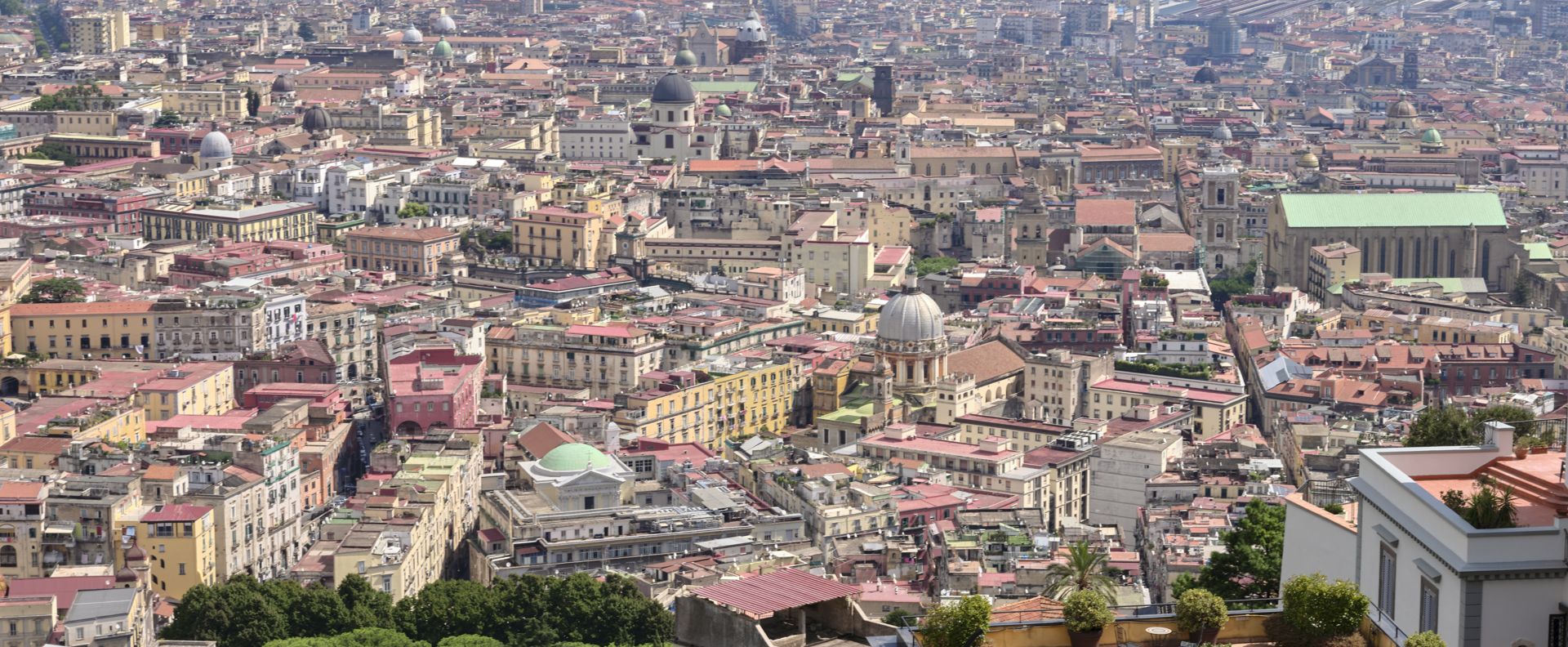
Santa Chiara is described on the maps as a “monumental complex” and since it includes a church, a convent, an archaeological site and a museum, that describes it fairly well.
Like many convents, there is a square cloister, decorated with religious frescoes, surrounding a central open area.
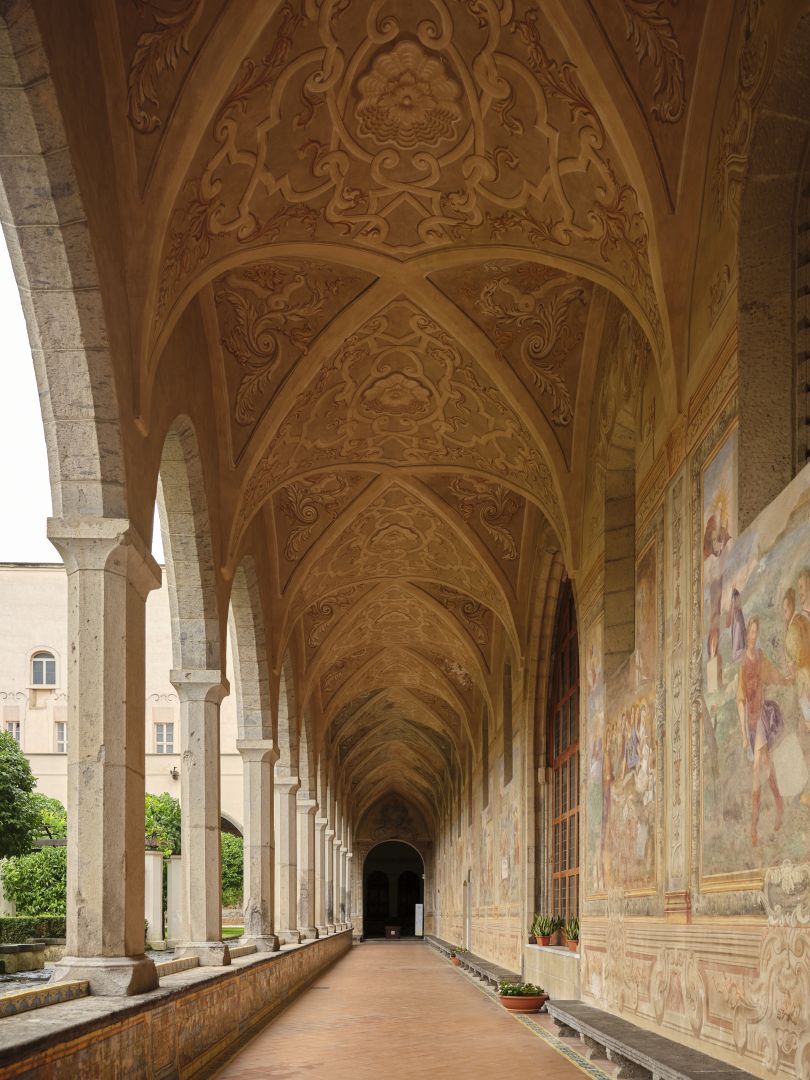
The large Gothic church, commenced in 1313, dominated the view of Naples for centuries. At the time Naples was ruled by the French Angevins, who had succeeded the Hohenstaufens of Frederick II. The picture below, painted 150 years later by which time the ruling dynasty was Aragonese, shows just how it dominated.
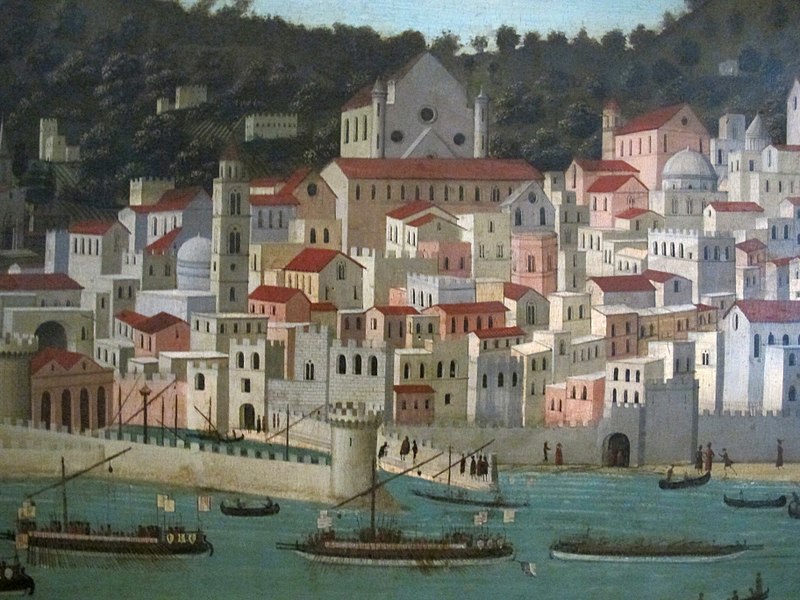
Meanwhile, back in the 1300s, the Angevin King Robert and his wife Sancha of Majorca were extremely devout followers of the Franciscans, the movement started by St Francis only about a hundred years earlier. The female version of the Franciscan order was started by St Clare (Santa Chiara) and in Italy they are called Clarissans after her. In England they were called the “Poor Clares” due to their vow of poverty. Queen Sancha took a particular interest in the Clarissans, joining the order after her husband’s death, so it is not surprising that the church and convent she and Robert established was dedicated to Santa Chiara.
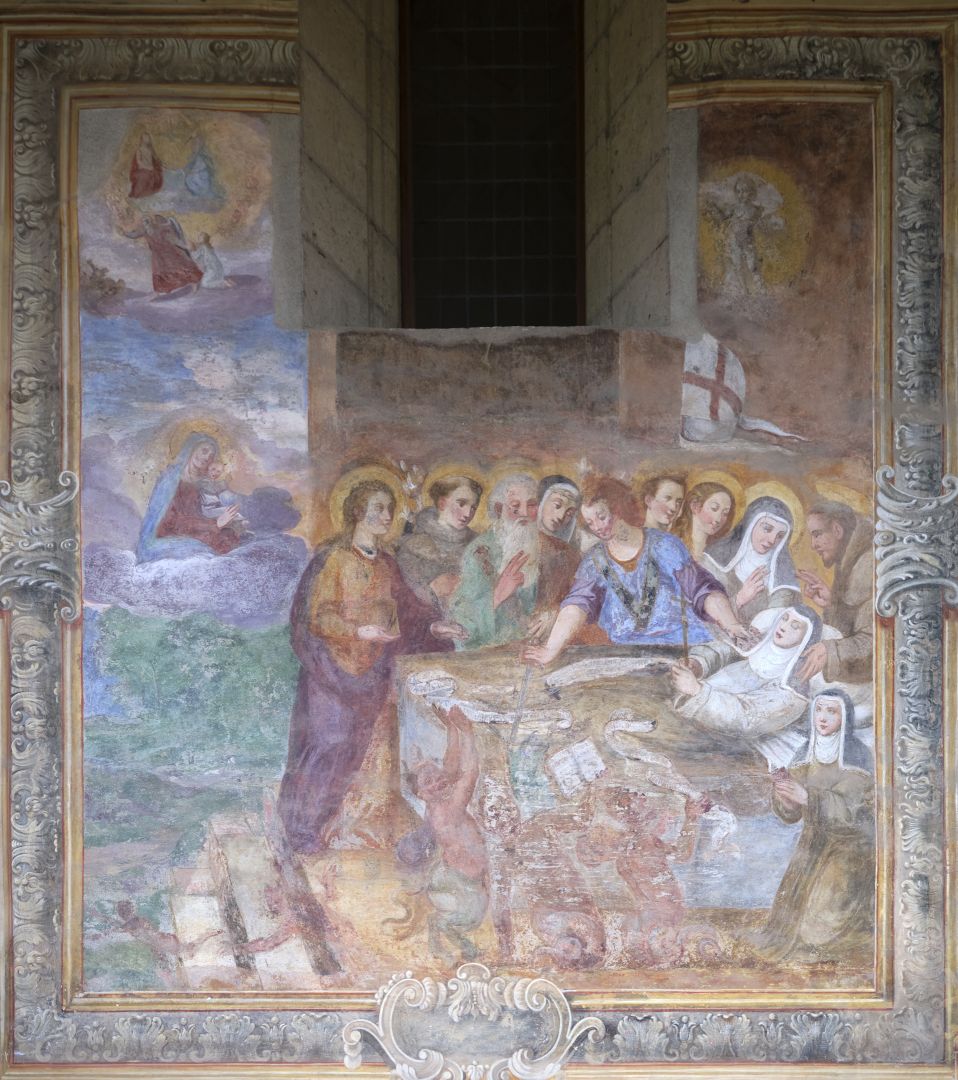
Fast forward to the 18th Century and another queen of Naples (by now it was ruled by the Spanish branch of the Bourbons) started taking an interest. The central area of the convent, surrounded by cloisters, was being used by the nuns as a vegetable garden. The queen, Maria Amalia of Saxony, thought it would be a good idea to smarten it up and decorate it with scenes which allowed the nuns to contemplate the life outside which they had renounced. She therefore commissioned an architect to convert the space into a formal garden crossed at right angles by two arcades of benches and columns, all decorated with maiolica tiles. I don’t know what the nuns thought of the idea but the result would certainly have been a very pleasant place for them to sit.
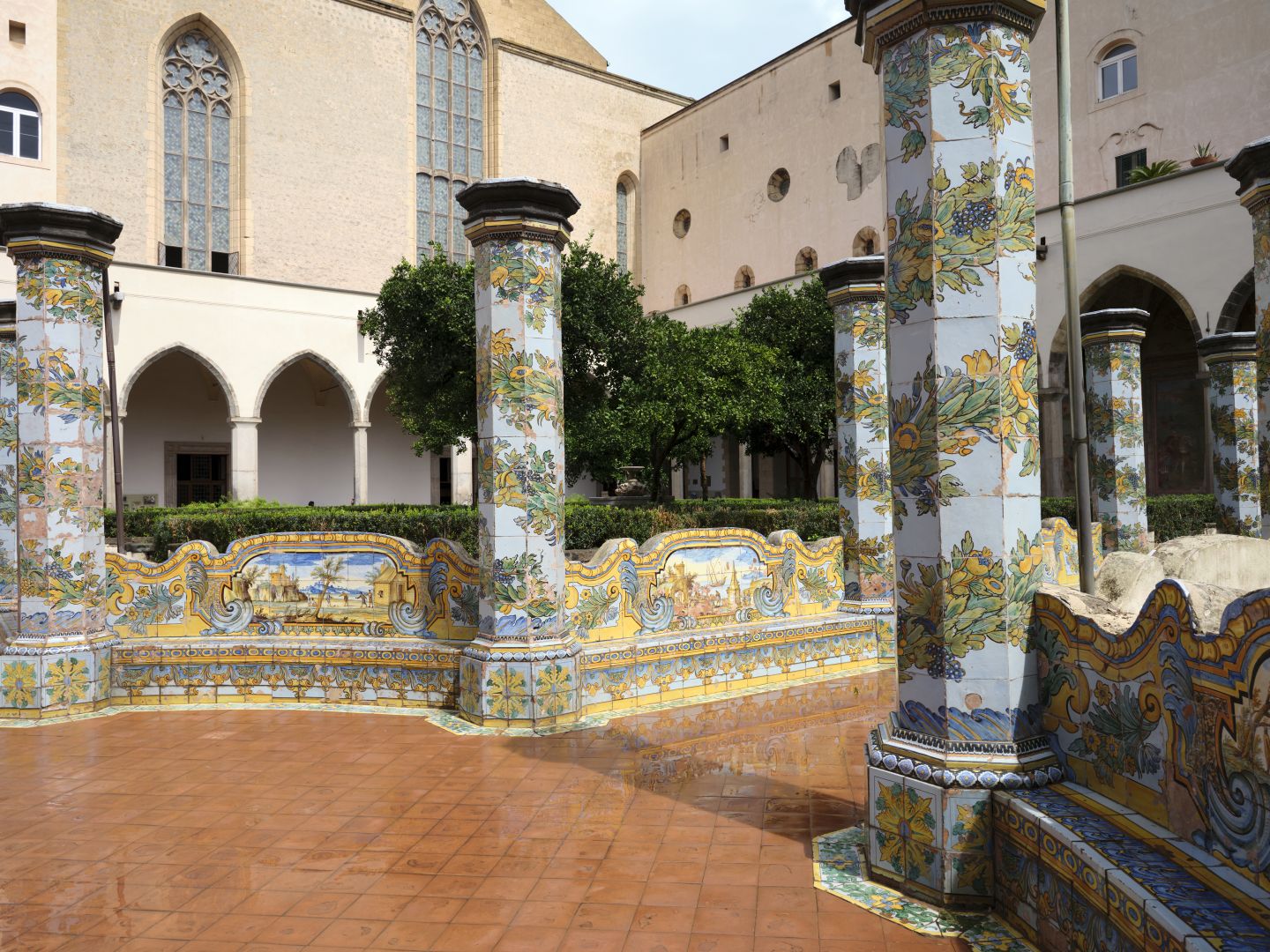
Catastrophe arrived in August 1943 when a raid by American B-17 Flying Fortresses started a fire which destroyed the inside of the church and its roof, although the adjacent cloister seems to have mostly survived.
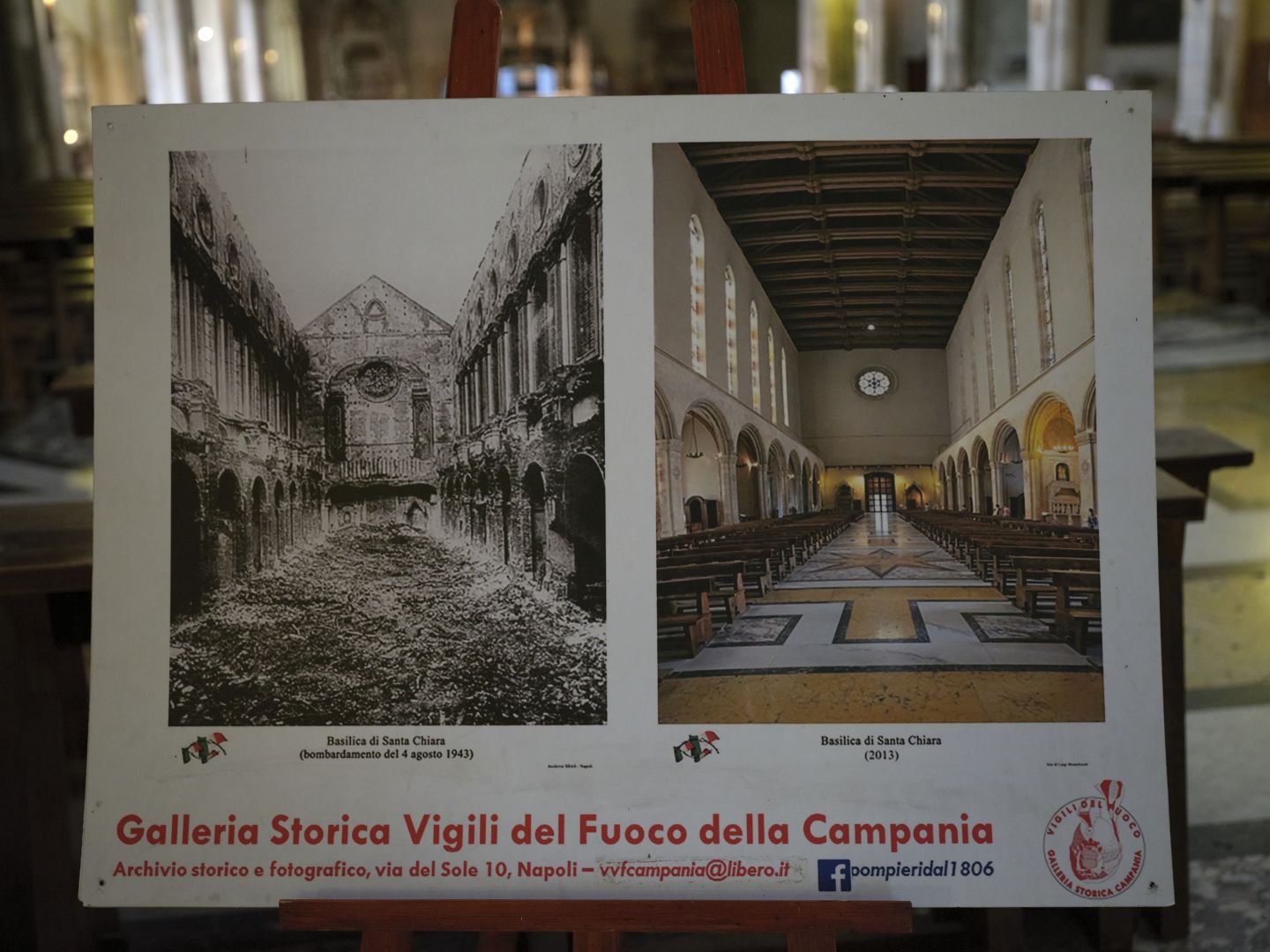
While many types of stone can survive a fierce fire, marble often doesn’t, and the photo below shows the remains of a marble frieze from the church, now displayed in the museum above a pre-war photograph of the original. Looking carefully at the remains of the original, it seems that there was an attempt to repair the frieze before they gave up.
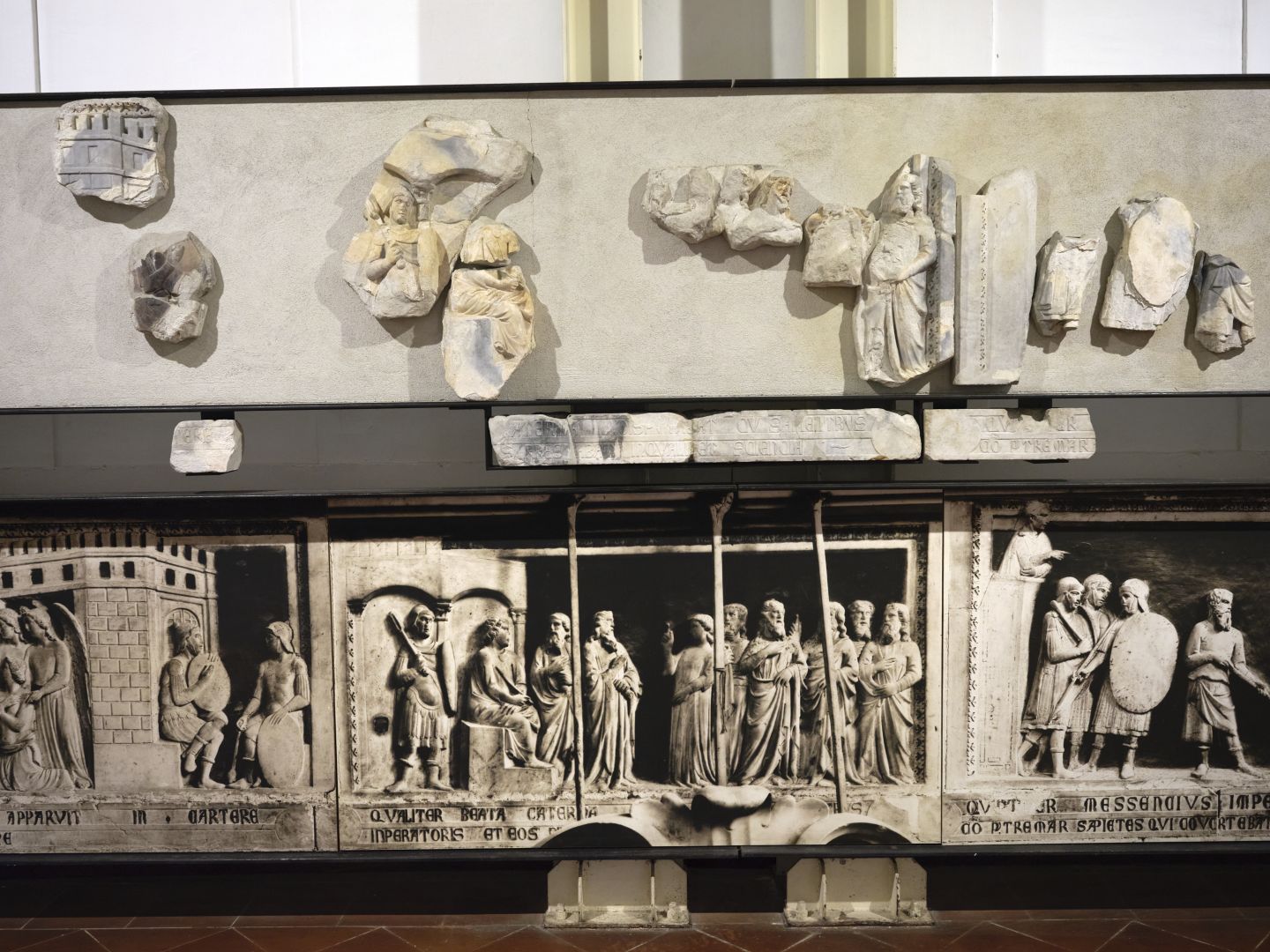
However soon after the end of the war, and despite all their other problems, the Neapolitans set about rebuilding their beloved church, completing the job in 1953. To modern eyes there is some small compensation for this. The interior had been redecorated in the 17th Century with some of the worst excesses of the baroque period, and without significant architectural merit. Pre-war illustrations of the interior show something like a wedding cake as imagined by Walt Disney. On acid.
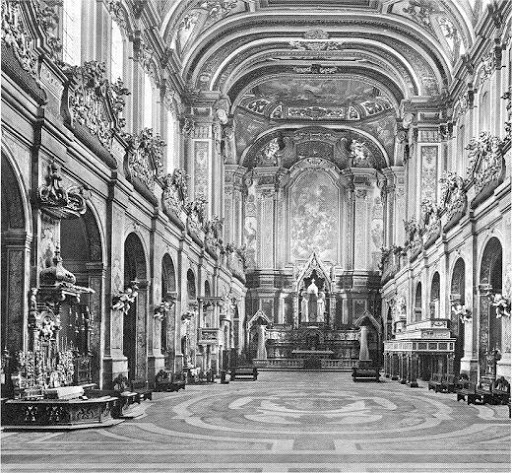
The architects responsible for reconstruction took the courageous decision to revert the church to its original austere Gothic nobility. One gets the impression that this was a bit controversial; not surprisingly many Neapolitans would have been wanting their old church back exactly as it was. But the Gothic restoration would certainly have been closer to Robert and Sancha’s Franciscan vision, and if it is over-the-top baroque that you want, you need only go to the church of Gesù Nuovo just down the road, which escaped damage in the air raids.
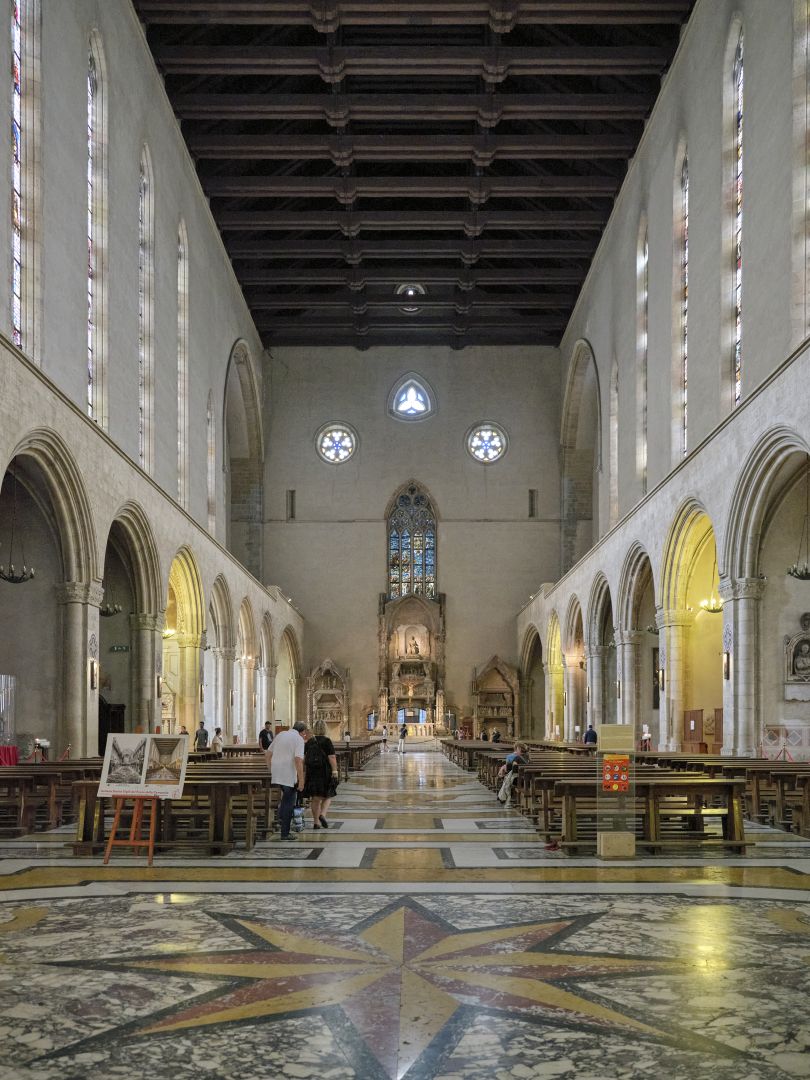
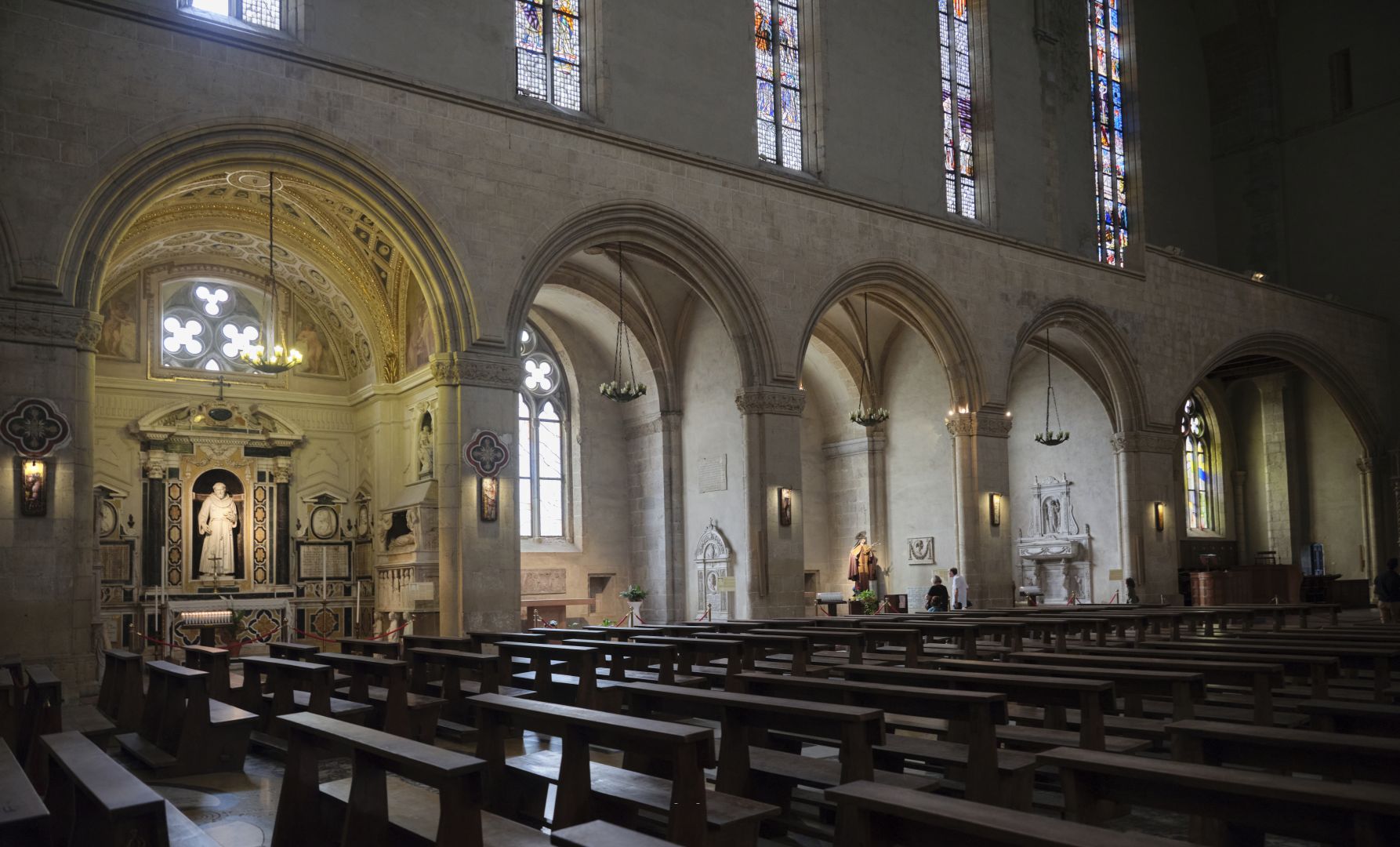
The Cloister
It was still raining quite hard when we got to the cloister, which was disappointing in a way, but it did at least mean that we could take pictures of the arcades without people in them.
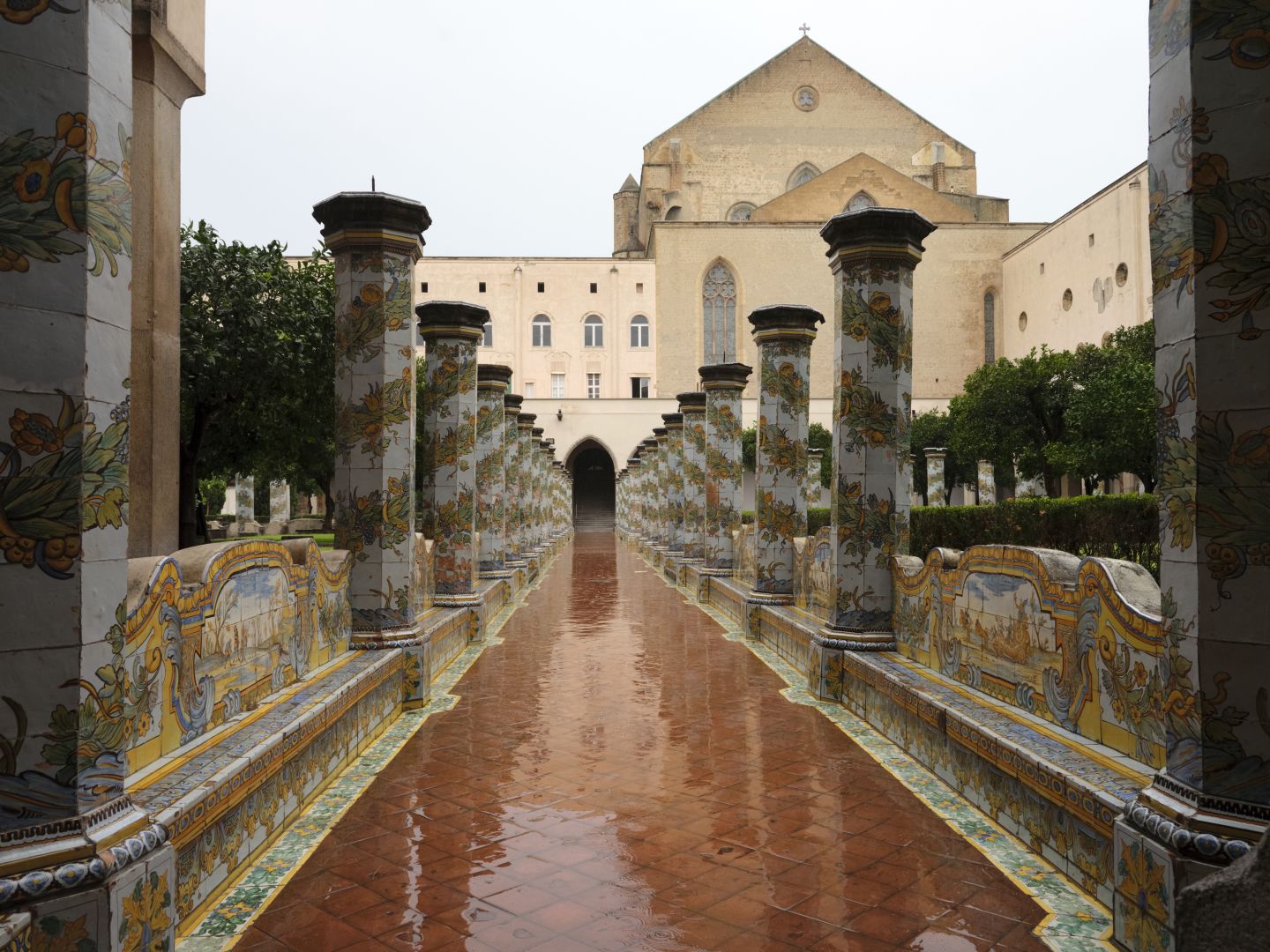
And then later the sun started to come out again so we got the best of both worlds.
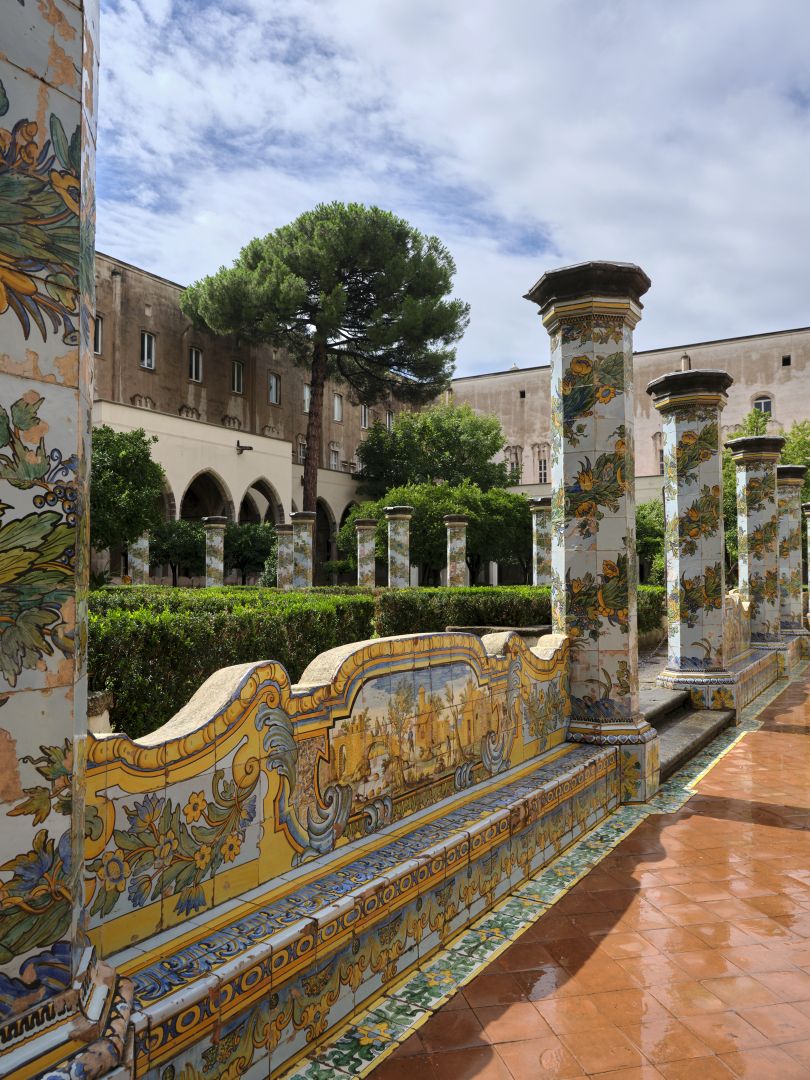
The maiolica pictures on the backs of the benches are charming. There are a few with mythological or literary themes, but most show an idealised version of real life – country scenes with peasants dancing, people working in the fields or unloading ships.
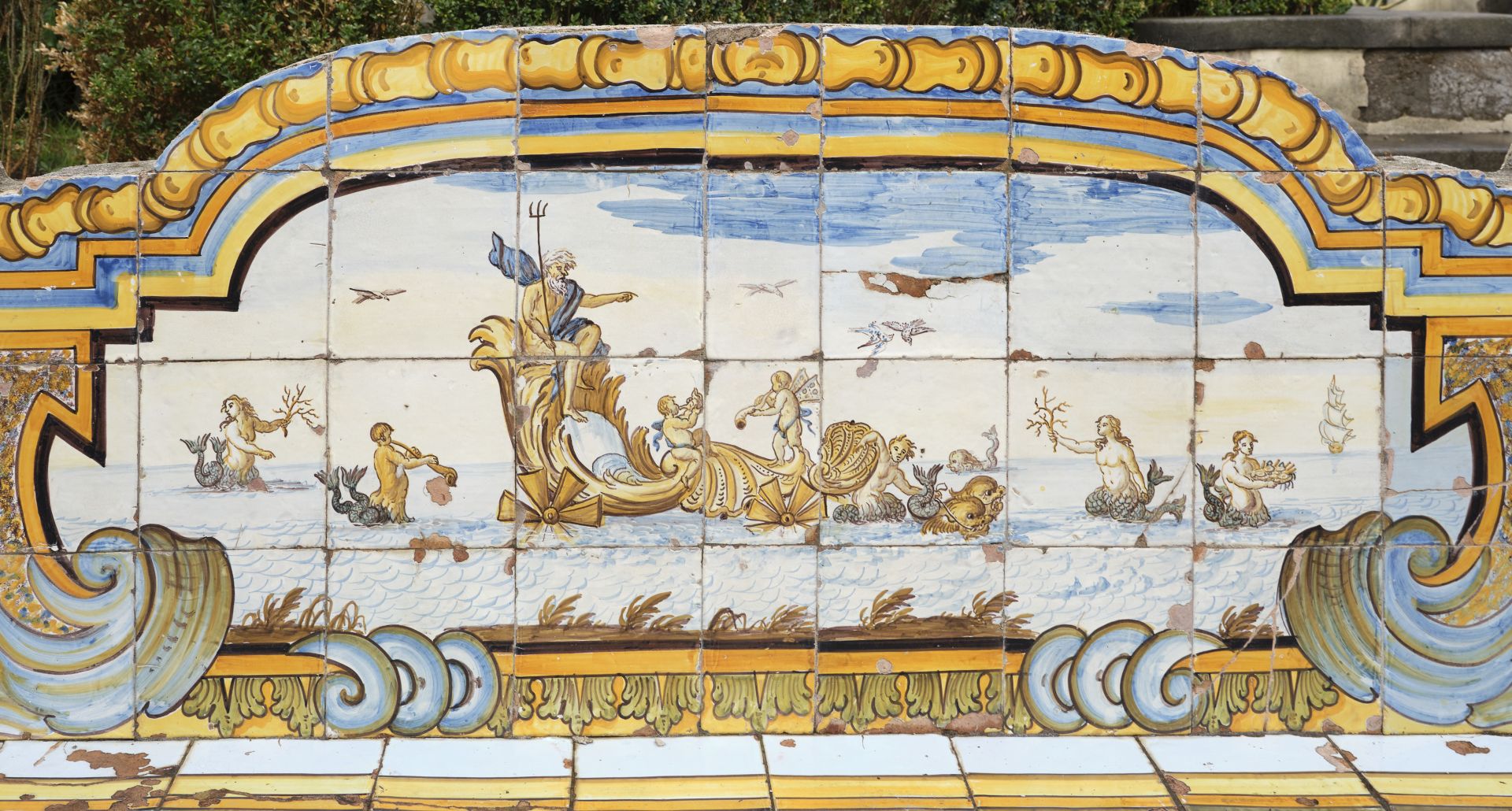
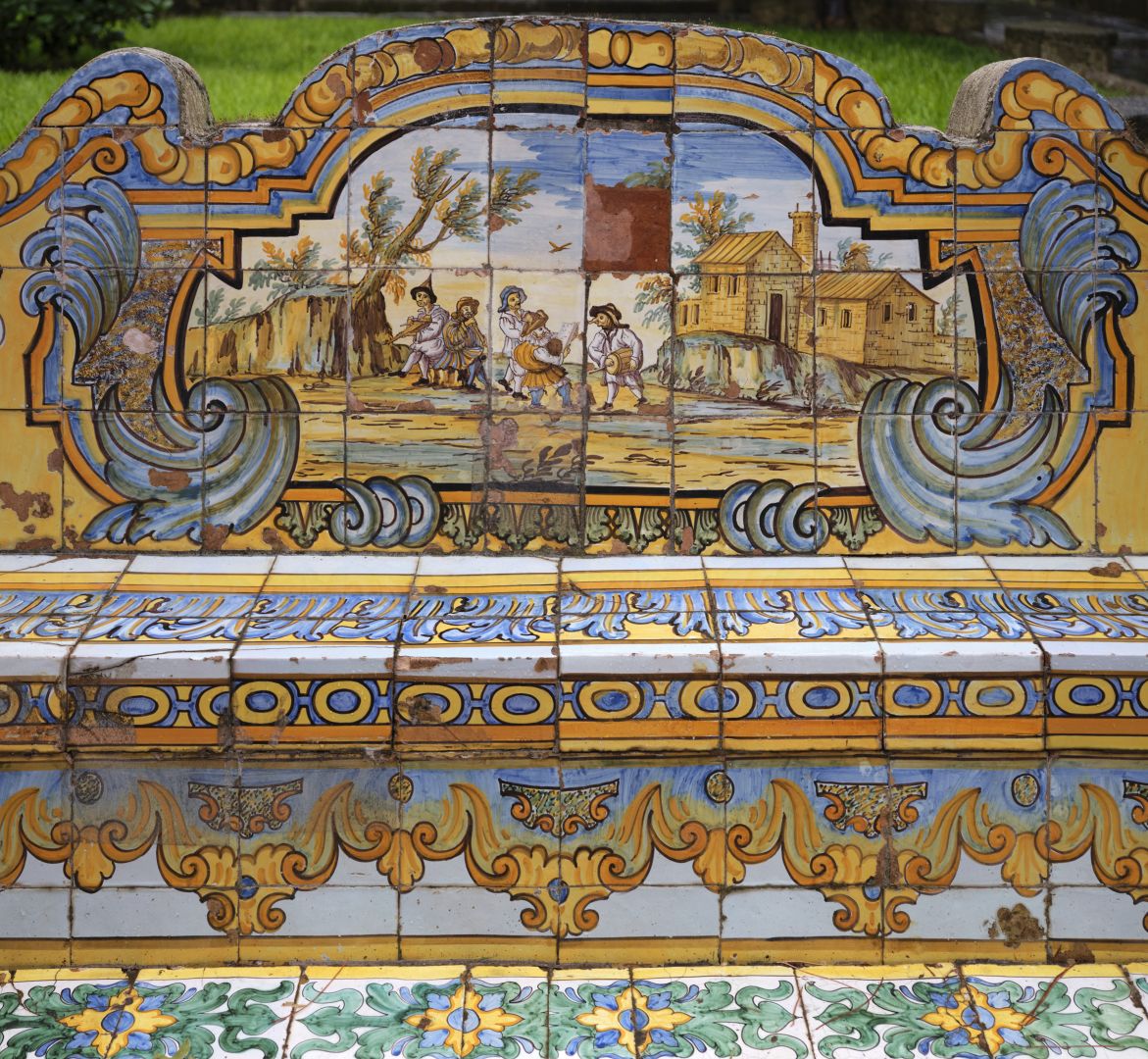
Several of the characters wear carnival-style masks and are doubtless supposed to be specific characters such as Pulcinella from the Commedia dell’Arte, especially in the scenes of rustic celebration. As I said, I don’t know how the nuns felt about it, but to me it does seem a bit mean to suggest that the life they had forsworn was one of continuous revelry.
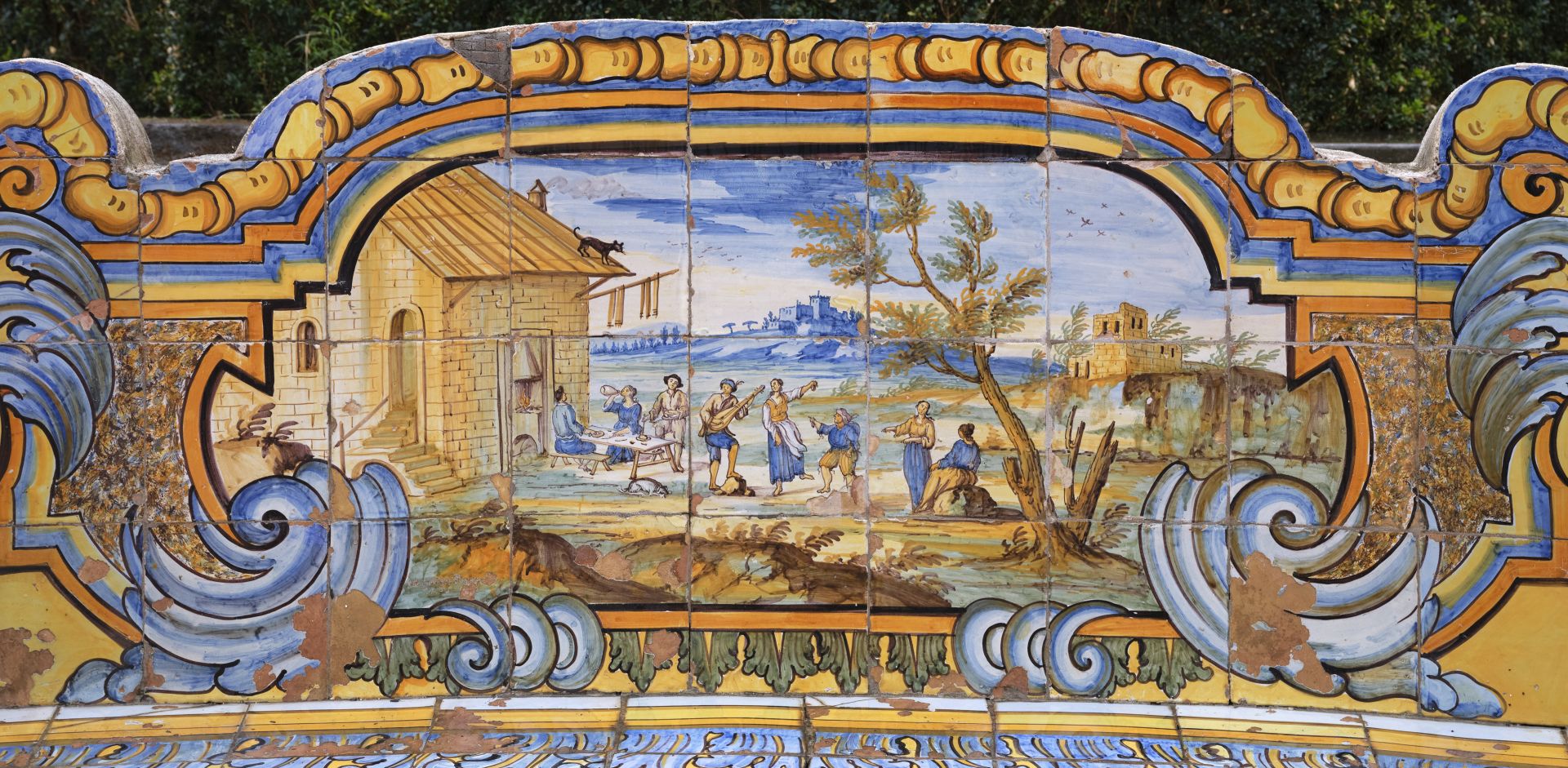
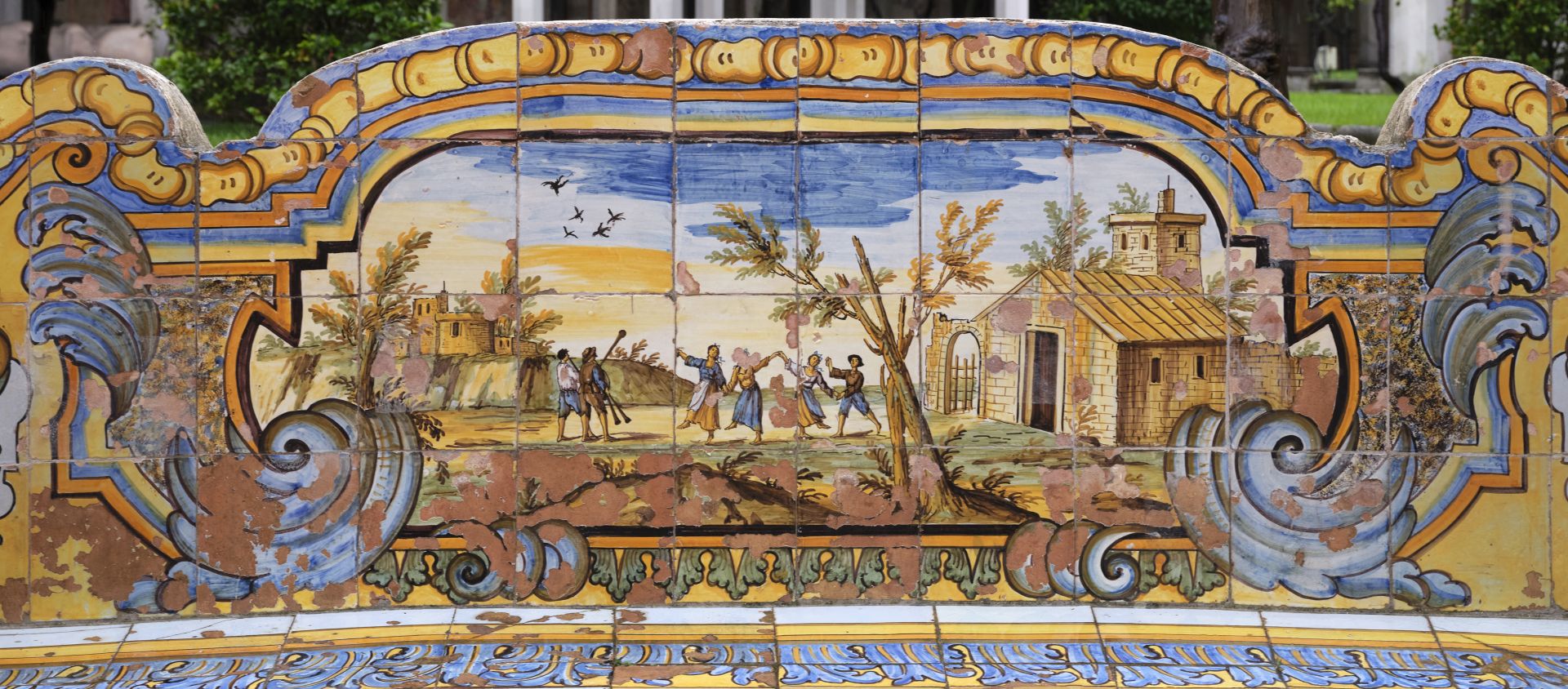
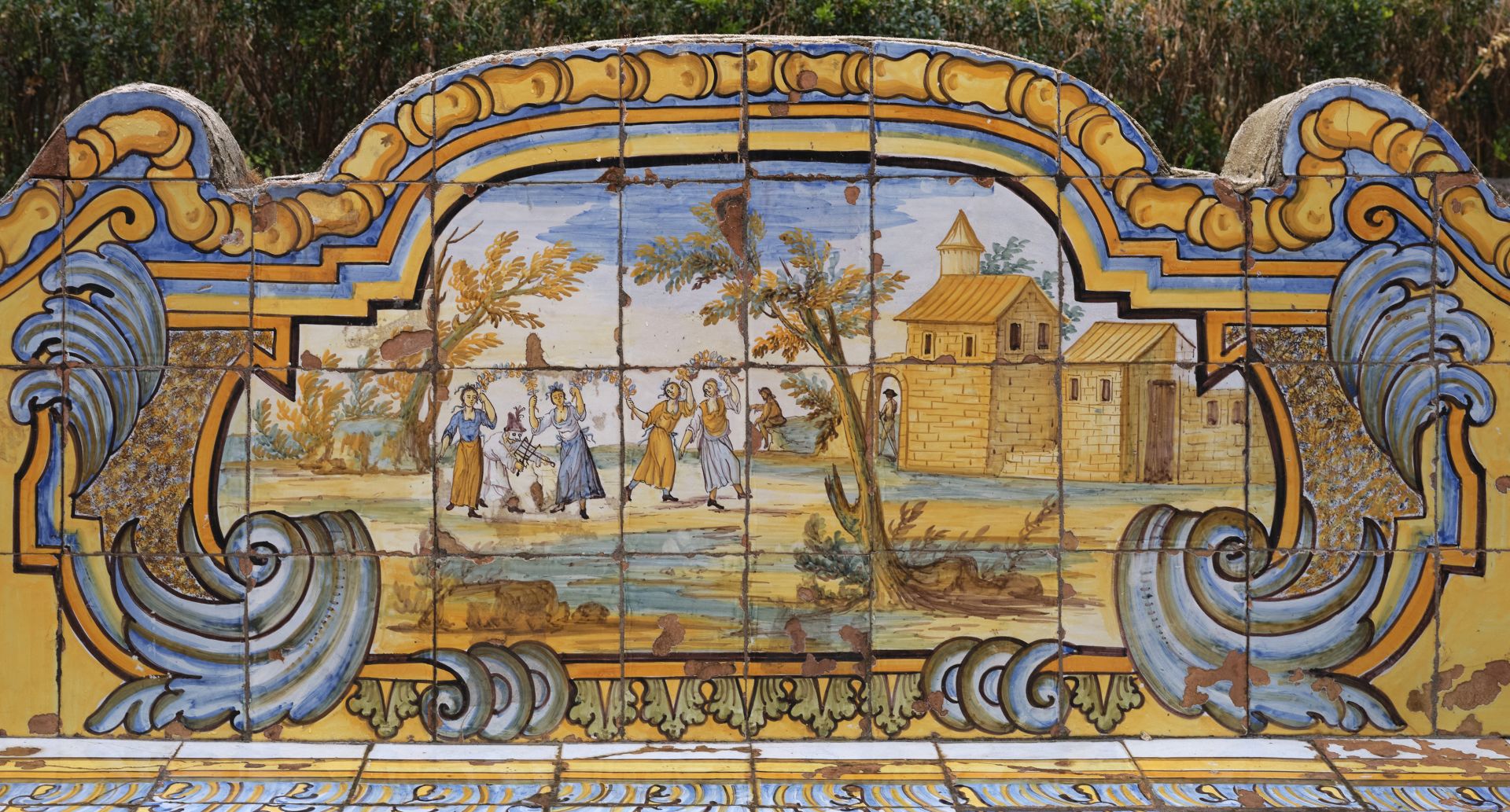
Unlike the frescoes in the surrounding cloister, the pictures that line the arcades are not religious at all, unless you count one of Santa Chiara herself, feeding cats. A lady we know in Umbria likes to feed the stray cats round about so in the museum shop we bought a bookmark showing Santa Chiara feeding the cats and presented it to her on our return. We were a bit nervous that she might think it frivolous, but she roared with laughter.
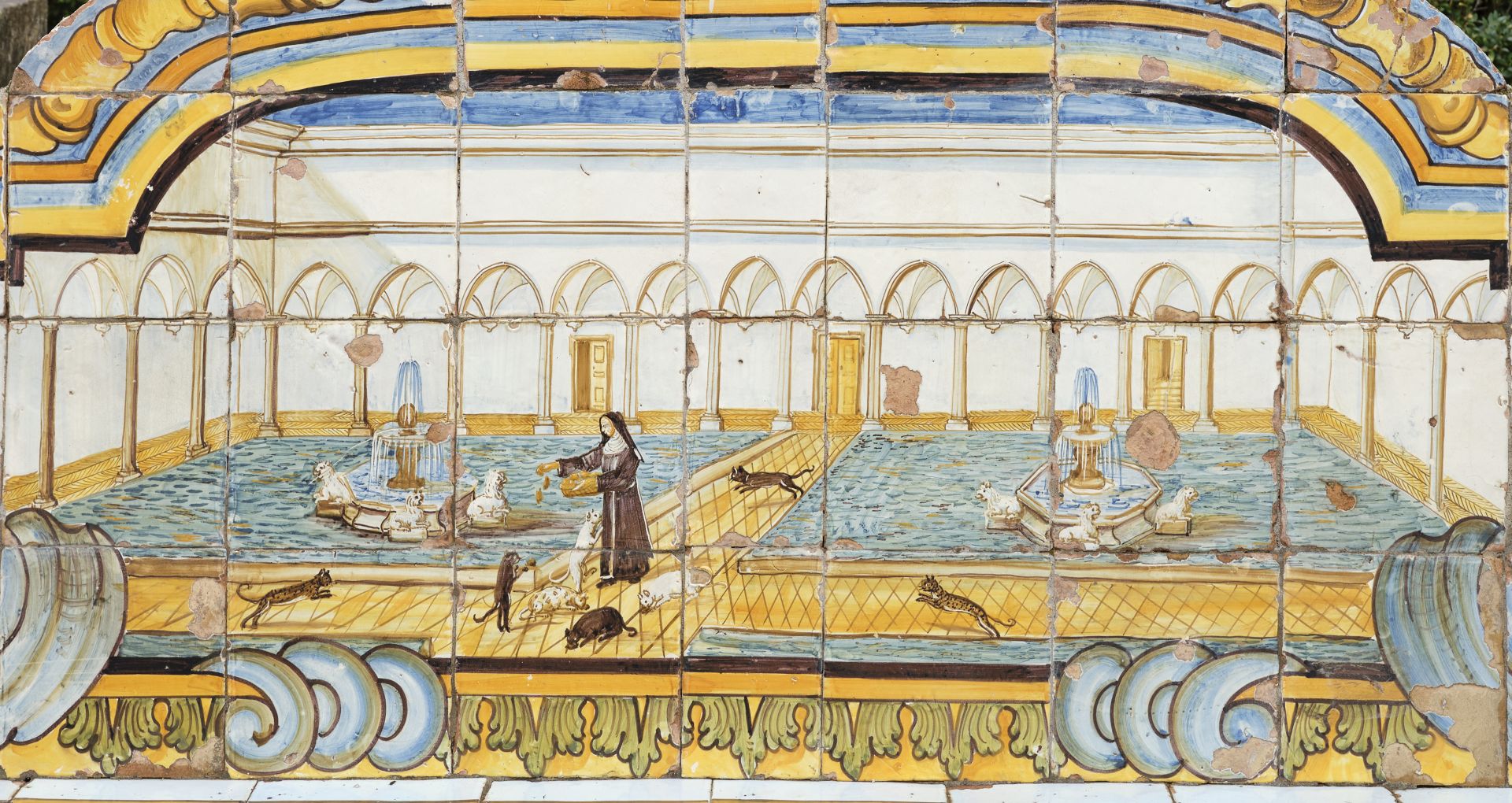
There was a restaurant near Santa Chiara, part of the Slow Food Movement, that we had selected for lunch, but Google was a bit optimistic about its opening time so we found we had an hour to kill. We therefore headed to a nearby bar for a pre-lunch aperitivo. That proved to be a rather Neapolitan experience. The Bar Settebello was small, full of cheerful people, and very noisy. But while in most Italian bars the noise would be coming from a TV playing pop videos or a football match, here the TV was tuned to RAI 5 (a bit like Channel 4 in the UK, alas no equivalent in Australia) and it was pumping out a performance of Rossini’s opera La Gazza Ladra (The Thieving Magpie).
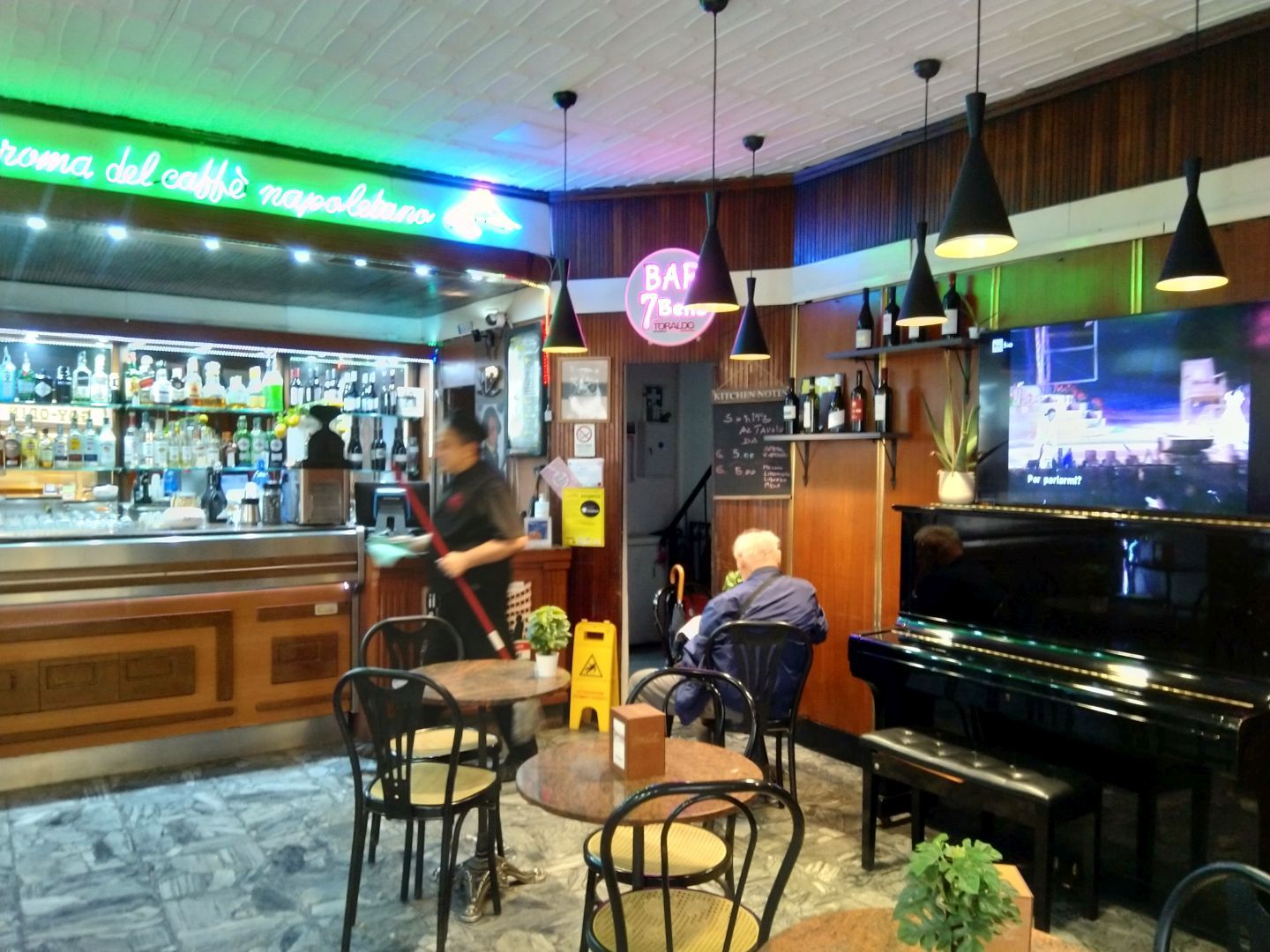
Update: I have now posted the promised articles on Procida and street life in Naples.

One Reply to “The Cloister of Santa Chiara in Naples”